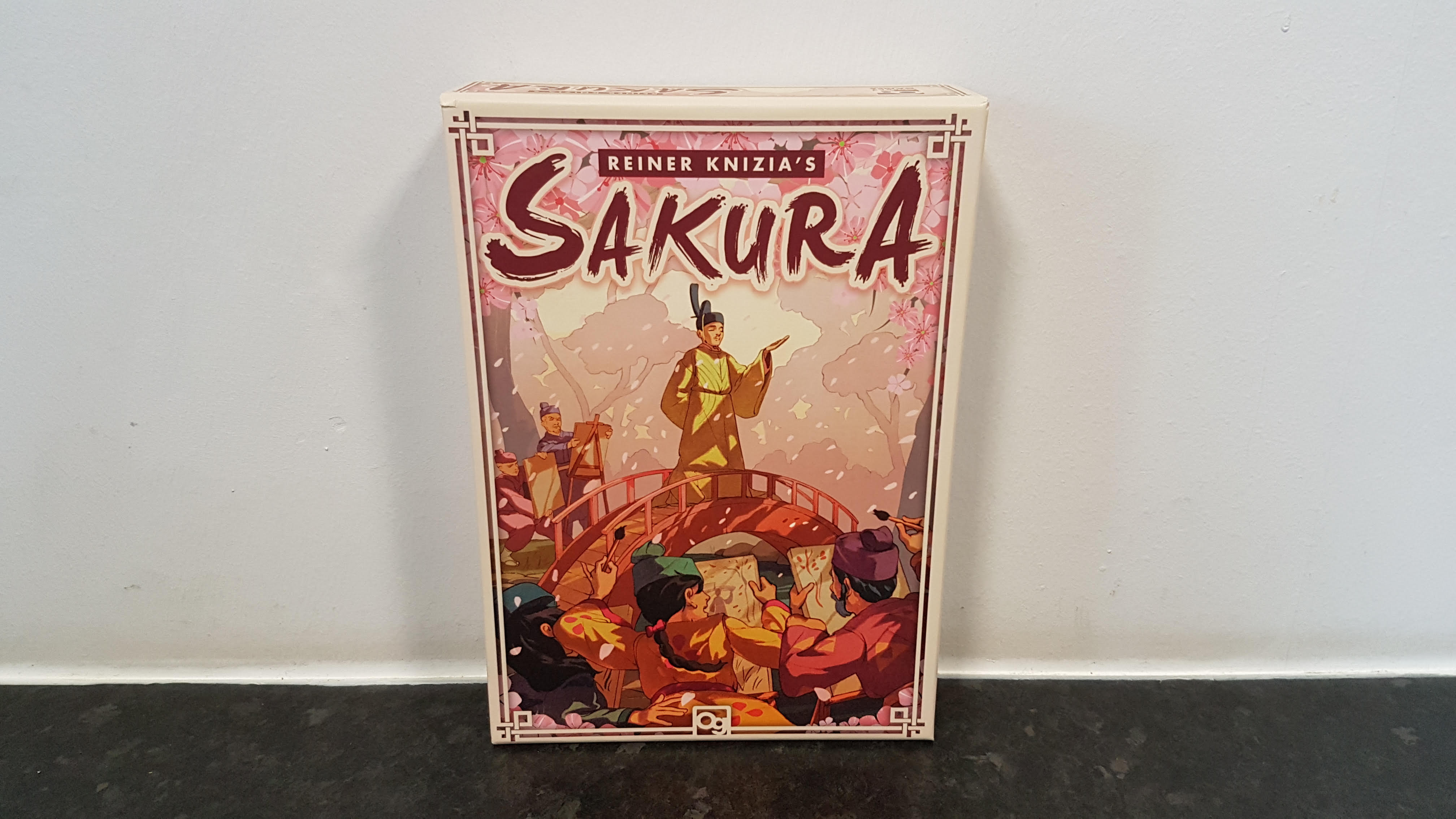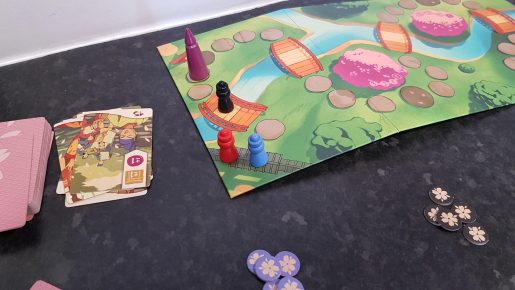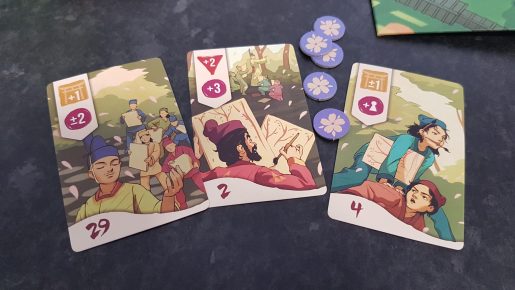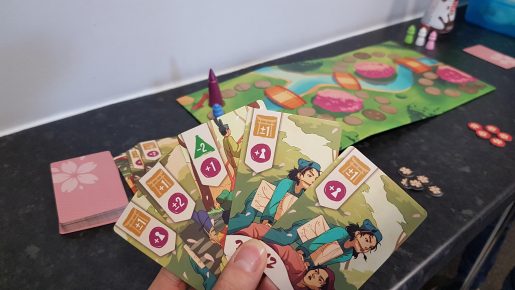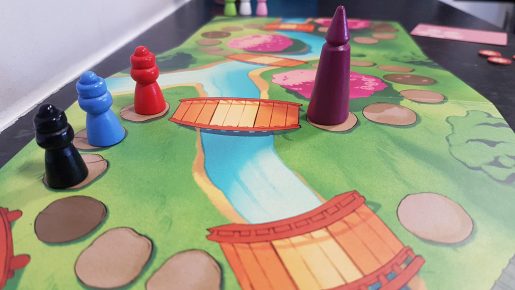Reiner Knizia’s Sakura, not to be confused with A-Games’s Sakura from 2017, has just been released by Osprey Games. This is a simultaneous action selection and programming board game where 2 – 6 players take up the role of painters. These artists follow the Emperor through his imperial gardens, stopping at key locations to paint his picture. Taking around 30 – 35 minutes to play, is this a masterpiece? Let’s find out!
Setup is extremely speedy, with the board being taken from the box, cards shuffled and 5 dealt out to each player, player colours picked and finally 5 victory point tokens distributed to players. Throughout a game of Sakura players will be selecting action cards from their hand. Selection is simultaneous, so all players will choose a card and place it face down on the table. At this point all cards are revealed and in numerical order, based on the cards, the actions will take place.
Each card has two parts which must be completed, no matter how detrimental they are. The top Garden action either moves the Emperor a set number of spaces forward or backwards, moves the front player back 2 or the player in last forward 2. Once this has occurred it is the player action, which sees the player move their own piece forward or backwards a set number of spaces, forward X spaces equal to the number of players in front of them or leapfrogging the player in front. Which actions take place are dictated by the card being played.
Whenever movement occurs for the painters they ignore spaces already containing another painter while trying not to bump into the Emperor himself. Hitting into or attempting to pass the Emperor brings disgrace on you as a painter. Not only do you lose a victory token, you are also forced to instantly move back 3 spaces from the Emperor.
The aim of the game is to be the closest painter to the Emperor when he make three stops, throughout the garden, at three Sakura trees. Whenever he reaches one of the three trees the current action card in completed, the rest from the round are discarded and scoring begins. For the first two trees scoring starting from the closest player is 3-2-1-1, with the last 1 point only being awarded to 4th in a 5+ player game. The final Sakura tree gives a slight bonus to coming closest offering 4-2-1-1. After the scoring of the third and final tree occurs victory point tokens are counted and the best painter is crowned.
Ramping up the fun of the game is the inner turmoil players will go through, as they pray their estimations come true. You’ll choose to play a card without exact knowledge, more of a hunch, of where the Emperor and the other painters will be. Based upon this knowledge, and how much your friends are out to get you, that card you have to action is now between you and points. It’s all about surviving what you’ve picked or throwing caution to the wind to screw over an opponent.
The resultant of this gameplay is that chaos will inevitably occur as players completely misjudge what others will have done before it’s their turn to complete actions. Many that go into the game expecting this chaos come out the other side thoroughly enjoying it, for the light-hearted gameplay it produces. The grimace as a player realises their card will be detrimental to them followed by the grins and cheers of others, as they pip players to be the best artists, creates an experience which feels like a fun jest at each other. To some this experience maybe too random, with little chances to plan ahead even in a two-player game. Just know what the gameplay will be like going in and don’t expect brain taxing decisions or grand programming strategies to consistently pay off.
The board is designed in such a way that it works with any player count. As the count increases additional spaces become used, in an intuitive way. In a game with 5+ players, suddenly the bridges that only saw the lighter beam used as spaces trebles in length as each space is used. While the board as a result grows, as more players are involved the amount of interaction is not only maintained but still increases.
The colours used in the design of the board, cards and player pieces are brilliant at capturing attention. It makes those in the room look, instantly intriguing them. Open the box as you start describing the title as a programming game and instead of seeing people tune out, these people will want to be involved. Visually the cards are decent, with a small selection of gorgeous illustrations that are similar in style to the box art. Alas, the card stock used is far from a solid industry standard.
The cards have an almost sticky feel to them, making shuffling for the first couple of games a nightmare. This is a problem from the offset, something gamers will notice as soon as they take the wrapping off the deck. Though it isn’t as game breaking as the difficulty in shuffling, the game board also presents a component problem. It is a very stiff board that often pops from the table instead of lying flat. The player pieces are designed in a way they’ll comfortably sit on the board instead of rolling, which is a saving grace. I’m unsure how these fundamental issues passed Osprey’s quality control: hopefully a future edition of this game will fix them.
At times Sakura can fall into a bit of a stalemate, as the Emperor piece is shuffled forward and backwards on a turn, ending up “stationary” or worse barrelling backwards. Doing this from time to time wouldn’t be an issue but it seems to consistently happen game after game, often lengthening the game by a good 10 minutes. In this time apart from slight re-ordering of players it can seem like little occurs, and this can be frustrating. If each round the Emperor is moved forward a space, after all action cards are complete, it does to some extent negate this issue. This is a simple house rule and generally speeds the game up, and as long as players know of the rule going in the game the gameplay still feels balanced.
Sakura is a rather lightweight programming game that is great to get to the table with gamers and non-gamers alike. With actions available being drawn from a deck there is a spot of luck involved but this is overthrown by the chaos that occurs as the player count rises. When it comes to this chaos there is a nice balance struck between complete mayhem and tranquillity at around 3 – 4 player mark, where your actions still influence the outcome but plenty of plans will be hilariously ruined. A lot of programming games revolve around this chaotic nature, not knowing what others are doing and how it could affect you. If this style of game interests you, and you can laugh when misfortune strikes, Sakura is definitely worth a play. If you can get past the production quality issues it might even earn a space on your gaming shelf due to the fun factor alone!
[Editor’s Note: Reiner Knizia’s Sakura was provided to us by Asmodee UK for review purposes. The game is currently available on 365 Games for £18.49. It is also available from local UK board game stores, find your local store here]

